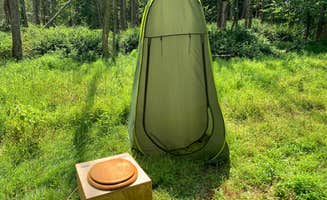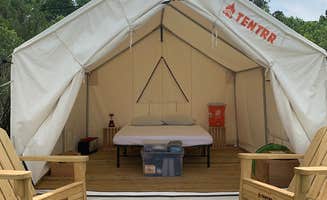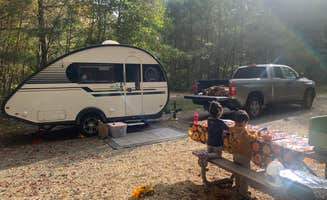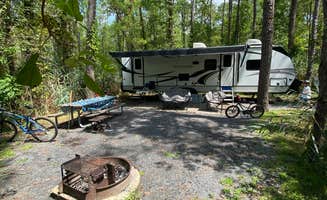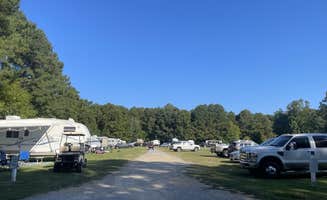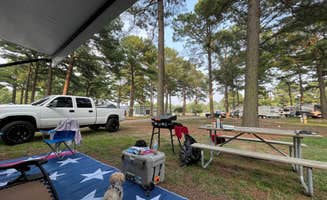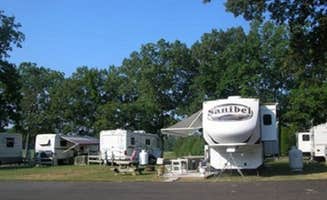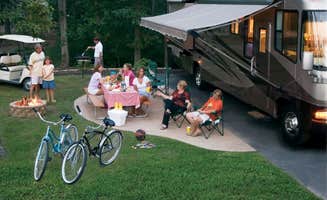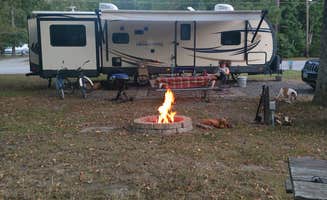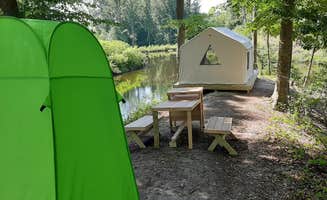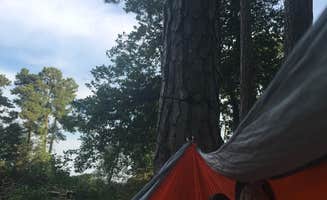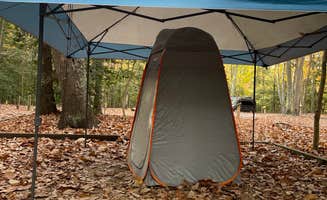The Northern Neck peninsula of Virginia contains numerous campsites near Heathsville, Virginia in marshy, coastal terrain typically situated just 5-10 feet above sea level. The region experiences strong seasonal variation with summer temperatures routinely exceeding 85°F with high humidity from June through August, while winter months often see freezing overnight temperatures. Fall camping tends to offer the most comfortable conditions with decreased insect activity and moderate temperatures.
What to do
Kayak through water trails: Janes Island State Park features an extensive network of marked water trails through marshlands that connect to a remote beach. "We were there mid July and the bugs weren't bad at all, a few mosquito bites, and the biting flies were kept at bay by cutter. We will definitely be back. The kayaking alone is worth the trip," notes one visitor to Janes Island State Park Campground.
Fossil hunting: Look for prehistoric shark teeth along shorelines, particularly at Westmoreland State Park. A camper at Westmoreland State Park Campground mentioned, "We came from Pa/De and wanted to look for sharks teeth. It was beautiful here so we decided to stay the night. Beautiful and relaxing."
Wildlife observation: The region hosts diverse waterfowl populations, particularly during migration periods. "There are so many pretty birds. This place was clean and quiet and everyone was very nice and friendly," reports a visitor at Thousand Trails Chesapeake Bay.
Fishing and crabbing: Most waterfront campgrounds offer dedicated piers for fishing and separate areas for crabbing. A camper at Point Lookout State Park shared, "There's lots to see around the campground. There's a short walk to a pier that takes you to the water where you can get some great photos of the landscape and some wildlife; various nature trails to hike."
What campers like
Full hookup availability: Several campgrounds provide comprehensive services including water, electric, and sewer connections. At Belle Isle State Park Campground, a guest mentioned, "Only 30 sites, all which have electric/water hookup. We've been here twice now, once with an RV and once in a tent. Most sites are shady and level, with lots of space between."
Water-based activities: Swimming beaches, boat launches and water access represent primary attractions. "The water is shallow and warm in the summer. In fact, the water is so shallow that you can wade almost 400 meters out or more! There are often crabs, small fish, and sometimes jellyfish floating about," states a visitor to Belle Isle State Park.
Clean facilities: Campground bathhouses receive consistently positive reviews. A camper at Point Lookout State Park noted, "Bath house was very clean and well-maintained. Looks like host cleaned it several times a day. Only two shower stalls, but they were nice and roomy with fairly hot water."
Historical sites: Several campgrounds feature Civil War-era structures and educational exhibits. "There's also a Civil War and nature museum, kayak and canoe rentals, and a nature trail," explains one visitor to Point Lookout State Park.
What you should know
Bug preparedness essential: Biting insects present significant challenges, particularly from May through September. A camper at Bethpage Camp-Resort explained, "Very secluded-get groceries before. Not much to do close by. Can get loud (we didn't mind)."
Site selection impacts experience: Waterfront sites often lack shade but provide views, while wooded sites offer more privacy and protection from sun. "Sites on the outside of the loop were private and long driveways. Inside the loop were more open," explains a camper describing the layout at Point Lookout State Park.
Reservation planning: Peak periods from Memorial Day through Labor Day require bookings 3-6 months in advance. "We took our 1st trip to Point Lookout the 1st week of June, glad we did. Tulip Loop has full hookups which was great, but the sites are basically in a swamp," mentioned one visitor.
Limited shopping options: Grocery stores and major retailers require significant driving distances. "Come stocked with food and water since I don't think there's any large food markets that are close by," advised a visitor to Belle Isle State Park Campground.
Tips for camping with families
Water recreation: Multiple campgrounds feature swimming beaches with gentle slopes appropriate for younger children. At Grey's Point Camp, a visitor reported, "There are so many activities for kids at this campground. There are waters slides, playgrounds, fishing, water rentals, and campground sponsored fun."
Planned activities: Several campgrounds offer structured recreational programs during summer months. "Belle Isle also has a cute little beach touching the Chesapeake. You can walk pretty far out and enjoy the warm water!" notes a visitor.
Playground availability: Most established campgrounds maintain playground facilities, though quality varies. "The little sandy beach is by far my favorite part of the park though! The water is shallow and warm in the summer," shares a camper about Belle Isle State Park.
Educational opportunities: Nature centers provide interactive learning experiences about local ecology. "This state park is one of the best in VA. With access to the Potomac River, beaches, shark tooth island (!), what seems like endless beautiful hiking trails and the cleanest camp grounds I have ever seen," explained a visitor to Westmoreland State Park.
Tips from RVers
Leveling requirements: Many sites require significant adjustment due to uneven terrain. A visitor to Belle Isle State Park mentioned, "Site #16 was perfect. It was gravel site that was level and very well maintained."
Hookup locations: Several campgrounds feature non-standard placement of utility connections requiring extended hoses or cables. "We had water hookups and electric. They also have firewood sold at the campground that they sell on the honor system," noted a camper.
Towing access: Certain loops contain tight turns challenging for larger rigs. "This campground is enormous, so bring your bike! You can choose a spot on the marsh and over the water or we choose to stay tucked into the back where there are full hookups," explains a visitor to Westmoreland State Park.
Site drainage: Low elevation means standing water occurs frequently after rainfall. "It rained the day we arrived. There wasn't a lot of rocks down, so we had mud all weekend, it never dried up," reported a Point Lookout State Park visitor.


